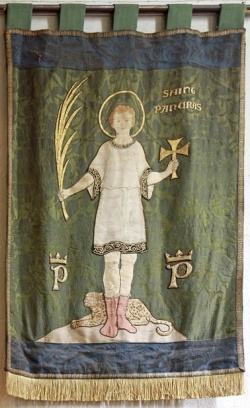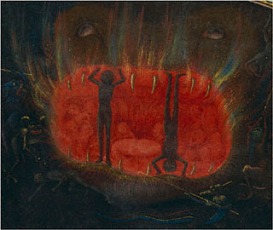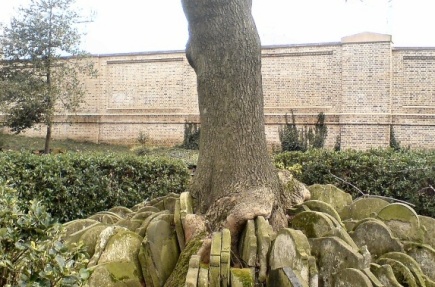There are a host of possible reasons for an unquiet grave. Ghosts themselves rarely articulate them in detail. However forceful they may be when it comes to communicating general anguish, getting to the nub of what troubles the dead can, for the living, involve little more than guesswork.
For John Tweed, the newly installed vicar at St Pancras Old Church when it suffered what appears to have been a mass supernatural manifestation in 1859, the initial cause of the phenomenon was clear: London’s over-stocked graveyards were being carved up to make way for the railway age.
The coming of the steam train uprooted corpses and headstones across London. St Pancras was bang in the middle of the new route north. But this alone shouldn’t account for the number of apparitions that haunted Tweed’s church and its grounds. Most souls rest easy, regardless. The vicar’s diaries, and the letters he wrote to his wife, Charlotte (who was to remain at their marital home in Buckinghamshire until things were ‘settled’), show he had further ideas as to what was animating the restless spirits he shared his workplace with.

In August, 1901, he wrote to Charlotte:
“Every thief, vagabond and ne’er-do-well in London seems to have wound up buried at St P. Which would be all well and good, except that the digging up of late seems to have unearthed more than just bones. Judging by the number of lost souls drifting about the place in one spirit form or another, I would offer that many of my guests are far from welcome in Heaven. I can only assume that having been buried in consecrated ground further precludes them from the other place, which leaves them, it is my horror to say, stuck in the churchyard with me”.
Tweed was not entirely without sympathy for his ghostly companions, going on to tell his wife that they were:
“Sad seeming things. I feel quite sorry for them. I don’t suppose I should mind at all if only they kept their mournful meanderings to the night-time hours. Last Sunday I was midway through service when a wraith came down the aisle – an infernal thing, it stalked among the shadows between the shafts of morning light, wailing and moaning like a baleful cat. There were already murmurings amongst the parishioners about the foul stench from the digging up. Dearest Charlotte, I am not sure how much longer I can pacify them.”

Any hope Tweed might have had of placating his flock, or coming to terms with his supernatural neighbours, faded as the events of 1859 developed.
In October of that year, Tweed sent a letter to his wife which appeared to mark a decline in his temperament. It wasn’t just that the apparitions were taking their toll. The vicar alludes to something new, something “strange and troubling”, happening in the graveyard. The letter is uncharacteristically vague, but much of it is fixated with the health of a young ash tree in the grounds of the church.

Whether Tweed was intentionally hiding the details from his wife is hard to say. Luckily for us, his diary entries pick up the story.
This is an entry from December, 1859:
‘Most unpleasant occurrences in the graveyard. Several headstones removed in the night, earth strewn about in a most unusual fashion. Not the railway workers, as it’s a Sunday. So who?’
And a few days later:
‘More missing headstones. Increasingly certain of connection with my guests. Today I traced strange lines of disturbed earth across the graveyard. Each lead to the ash tree. Are they being dragged there? And then where? The ash tree itself is looking increasingly unhealthy, possibly diseased. I don’t like to get too close to it.’
And then:
‘If I hadn’t seen such as I have seen these past months I may not have trusted my eyes, but trust them I must. I shall record it in as plain a manner as I know how: By the light of the moon last night I saw a gravestone, moving with some speed, and quite of its own accord, across the graveyard. It hurtled towards the ash tree, at the base of which it disappeared, as if plunging in to the very bowels of the tree.’
Finally:
‘Good God. Hundreds of them, of all shapes, just pouring into the tree.’

So what was happening here?
“A Category 2 hellgate”, says Susan Macks, Professor of Gateways and the Multiverse at the University of Connecticut. A good friend to PoL, Susan’s work has inevitably drawn her to London and what she terms its “filo-thin dimensional membrane”. When we meet over flat whites and sandwiches in her favourite Bloomsbury cafe, she is excited.

“I’m not talking your full scale hell mouth – not a main entrance. But yeah. Look, like the vicar says, these spirits are stuck. Too bad for heaven, but too buried in holy ground. And then their bones get all dug up. Would you be happy? They mope about the graveyard, desperate to change their situation. Then they find the tree. Except to them it’s not a tree. It’s a wrinkle, a snag, like that one corner of sticky tape that your fingernail finds on the roll. Now, for whatever reason – maybe the tree’s roots aren’t sanctified, or maybe some godless killing took place beneath its boughs at some point – anyway, one of these ghouls manages to get a toe through the gap between church world and the underworld and pow. That’s it. You don’t have to ask these lost souls twice. Eternal damnation is a relief for these guys.”

John Tweed seems to have been thinking along the same lines. On the 30th January, 1860, he wrote to his wife for what appears to be the last time. The letter is rambling, desperate and disturbing. It bares quoting at length.
“Dearest Charlotte, I do so love hearing your news from the vale, it pains me to have to recount the horrors of my life here… When you open a window to let out smoke does it not allow cold air in also? When you open your heart to the voice of a lover, does not some precious part of your soul seep into their heart also? Oh dearest love, there is a deep sense of foreboding about the place… My flock has flown, but I am far from alone… At night I am plagued by nightmares so vivid and dreadful that I am afraid to sleep at all. I have been nailed to the cursed iron frontage of a flame-licked and hell-bound locomotive. I have walked through the dark miasma and fetid slime of a London choked by death. I have seen the flagstones of the church floor thrust violently upwards by a sudden eruption of uncertain origin. And these are only the visions I have the constitution to retell… I begin to suspect that it is not just the lost ones that are being dragged down to that place. For how to account for the sheer number I watch descend every night? Where will it end? Must every dead soul in the parish, every dead soul in London be reclaimed for damnation?! No Charlotte, I shall not see it happen.”
So exactly how and when did this hellgate close? Frustratingly, John Tweed’s diary entries come to an end around this time, too. However, Macks thinks there may be a simple reason for this: John Tweed lost the ability to write. That is, he lost the use of his hand. Church records back this up, but they aren’t the only source of Macks’ theory. She says that scans have shown that buried within the roots of the ash tree is a large book. She has failed to be granted a dig, but that hasn’t put her off theorising.
“You want my 99.999% certain guess as to what book that is down there?”, she emails. “It’s the bible. Only way I know of to close a Cat 2 hellgate is if a holy person rams a holy book into its mouth. You gotta say the right words of course, and according to who you ask you may or may not have to dance a jig and wrap three strands of hair around the thing beforehand. Either way, I reckon Tweed figured this out and put a stop to the whole darn thing. That’s why there’s no talk of any disturbances after early 1860, and why John stops writing his diary then, too. We know from John the gate nearly killed that tree. Imagine what it might do to any part of a man’s body he cared to stick in there”.

What’s certain is that the hellgate seems to have been closed between early 1860 and 1863, when John Tweed ceased to be vicar at St Pancras. There are no records of any disturbances from his time onwards. After that John and Charlotte’s trail goes cold. The one clue we have as to their wellbeing (other than the fact that three and a half years is exceedingly short tenure for a vicar) comes from Charlotte. One letter, dated March 1863, is present within her husband’s papers – its presence there suggesting it was never sent. It is addressed to Charlotte’s mother and speaks of a tentative hope for the future: “although, I am perhaps not as hopeful as John that the darkness within him will be left behind when we go”.
Anyone can read the papers of John Tweed. Despite the account they give of the origins of a notable local sight, the true history of the Hell Tree is in danger of being lost to posterity. A rival mythology has arisen around the tree, perhaps reflecting Londoners’ willingness to ignore, or forget altogether, their city’s predisposition to portals of all kinds. For whatever reason, there is little celebration today of the story the tree tells: that of the quiet sacrifice of a loyal and committed member of the clergy.
- Candidate: The Hell Tree, St Pancras.
- Type: Hell Gate (Secondary)
- Status: Historic

Thanks for the follow and the nice interpretation of the Hardy tree. Makes for an interesting read
LikeLike
Thank you! Loving your writing on London
LikeLiked by 1 person
Love to know what you guys are up to – creating folklore? Cleverly weaving bits of facts with fiction – big flashing light with the dating of the vicar’s first letter being 1901, then suddenly back writing in 1850s! Lead me to a nice bit of detective work though. 🙂
LikeLike
Thanks. It’s a voyage of discovery for us, too!
LikeLike
Great article, thank you. I used to walk past the church for many years on my way to work, didn’t realise the history of it!
LikeLiked by 1 person